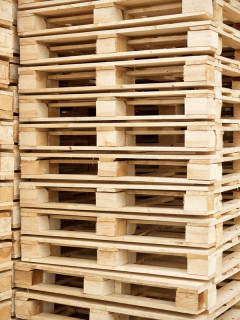Delivery by pallet is becoming increasingly popular and requires shippers to set up an increasingly detailed and precise management system, with the aim of reducing the costs and environmental impact of this type of packaging.
Between rental, fleet management and exchange, how to choose a pallet management system?
NB: In this article, we will focus on EUR EPAL type pallets, whose management can be standardised. For more information on these pallets, do not hesitate to consult our article Which type of pallet to choose?
SUMMARY
 The pallet exchange system
The pallet exchange system
The principle of pallet exchange
The sending company, which owns its pallets, entrusts its palletised goods to the carrier.
The carrier then delivers the pallets to the receiving company, which entrusts it with the same number of pallets as were sent to it. These pallets must be in the same condition as when they were received.
It is then up to the carrier to return these pallets to the sender.
The advantage of this pallet management system
The costs for the carrier are lower than with other more expensive systems.
The disadvantages of this system
- The pallets, transported over sometimes long distances, are not always returned in the same condition as they were shipped.
- This system has a cost for the carrier, who is not paid for this service.
- In the standard case, the logistics manager has to store the pallets, which he undertakes to return to the carrier once the pallets have been released. This means immobilised storage area for a product with no commercial value, as well as additional handling for the teams.
A more responsible pallet exchange system: Magic Pallet
What if it were possible to locate and exchange pallets with colleagues closer to you, and thus save kilometres and tonnes of CO2? This is the challenge taken up by the start-up Magic Pallet, which is promising for transport operators concerned about their pallet budgets and the environment.
Discover the interview with the founder of Magic Pallet

Pallet rental
The principle of pallet rental
There are companies that will deliver pallets to you at the exact moment you need them,
renting them to you and collecting them from the recipient after delivery and returning them to their own warehouse.
The advantage of this pallet management system
These pallet rental companies can also make suggestions on the type of pallet to choose according to your type of shipment:
recycled plastic pallets for internal flow logistics, moulded pallets or ISPM15 standard pallets for international shipments, etc. There are many possibilities, and these rental companies can help you choose the best solution for your project.
The disadvantages of this system
- Costs are often high for shipping companies, as you pay an extra charge each month for a shipping solution.
- Pallets spoil more or less quickly; the faster your interim rate is high, or the faster you manage overflow stocks with external teams that are generally less involved in the overall quality of service.)
 Pallet pool management
Pallet pool management
The principle of pallet pool management
A logistics service provider dedicated to pallets relocates your EUR EPAL pallets and then delivers the right pallet for your needs, based on a pallet credit/debit system.
The advantages of this pallet management system
- Precise organisation of supply, return management and pallet maintenance.
- Your pallet management strategy is part of a circular economy, which is good for all stakeholders
The disadvantage of this system
This service has a definite cost. However, pallet storage space and the handling of pallets by in-house teams are not valued. It is therefore sometimes considered an additional, unnecessary cost
As you will have understood, each EUR EPAL pallet management system has its advantages and disadvantages. The objective is to choose the one that suits you, depending on your ability to mobilise your internal teams, your storage space in the warehouse, but also on the budget you can allocate to it.















